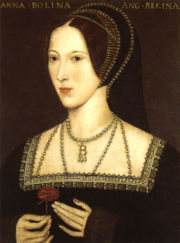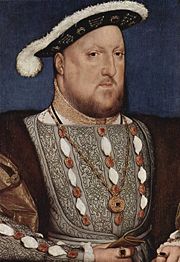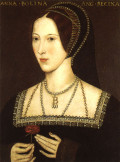- HubPages»
- Education and Science»
- History & Archaeology»
- History of Europe
The Wives of King Henry VIII: Anne Boleyn

A Sinner or a Saint?
She's one of the most enigmatic characters of her time: Anne Boleyn. Her charm, grace, and wit were legendary, but so were her cunning and spite. She was the mother of perhaps one of the greatest rulers the Western world has ever seen, but she didn't live to see her daughter grown. A woman who loved parties, gossip, and jewelry, Anne was also the woman who captivated a king's heart (or at least his loins and his mind). We can never really know the true nature of Anne Boleyn, just as history will always be clouded by the fog of time. We can only glimpse into what history tells us about her, which may not be as fascinating as the real Anne, but even on paper she still seems remarkably vivid.
Youth and Life Abroad
Anne was born sometime between 1499 and 1507 to Sir Thomas Boleyn and Lady Elizabeth Boleyn (born Elizabeth Howard). Sir Thomas was the son of the 1st Earl of Wiltshire and Elizabeth was the daughter of the 2nd Duke of Norfolk, so both of her parents were well connected. Sir Thomas was a gifted linguist and diplomat who held high favor with King Henry, and was often sent on important diplomatic missions to all corners of Europe.
Thomas Boleyn so impressed the Archduchess Margaret of Austria gave his daughter Anne a place in her retinue. Anne made a good impression in the Netherlands, and her father soon arranged for her to have a place in Queen Mary' entourage as a maid-of-honour. She soon moved on to an even higher position as a maid-of-honour to Queen Claude of France. Anne was very enamoured with French culture, cuisine, and fashion, and learned much about poetry and dancing as well. Her education in France would serve her well in the English court, where she would be known as a trend setter among the ladies.
This education was to her credit, because Anne was not known as a conventional beauty by English standards. Her dark hair, olive complexion, and brown eyes were the exact opposite of the ideal blond-haired, blue-eyed maiden. But she could dance, joke, and sing exceedingly well, and her wit made her more than a match for Henry.
In 1521 Anne was brought back to England by her father in order to marry her cousin James Butler, to settle a dispute over the Earldom of Ormonde in Ireland.

Life at Court
For many unknown reasons, Anne's marriage to James Butler never happened, though it is suspected that her father had grander ambitions for her.
When Anne first entered court as a lmaid-of-honour for Queen Catherine, her sister Mary was actually Henry's mistress. Mary was married to Sir William Carey, a Gentleman of the Privy Chamber who was very high in favor with the King. It is even thought that one or both of Mary Carey's children were fathered by Henry, but it is truly an unknown. For the next several years King Henry carried on with Mary, and Anne courted Lord Percy, son of the Earl of Northumberland.
In 1525 however, Henry became besotted with Anne. He began his pursuit of her, despite her rejection of him. Though she initially was reluctant to become his mistress, the force of Henry's personality and power was ultimately too much to overcome.
Courtship and Marriage
By this point, Henry had quite possibly been incubating the idea of getting an annulment from Queen Catherine for quite some time. She was some years older than him, and had only produced one living child, a girl. Henry had no heir, and this was a point of constant worry for him. In Anne he saw not only a sharp and witty woman, but also a chance to conceive a male heir upon a younger woman. Henry began his attempt to gain an annulment in 1529, but the pope was unwilling to grant the King his wishes. At the time the pope was the prisoner of the Holy Roman Emperor, who also happened to be Queen Catharine's nephew. Doubtless, this had an impact on his decision. Ultimately, it was this refusal that caused Henry to split from the Catholic church to create the Anglican church, with Anne by his side.
By 1531 Henry had banished Catharine from her old rooms at court and placed Anne in them, though they were still unmarried. When the Archbishop of Canterbury passed, Anne helped install family friend Thomas Cranmer on the seat, thus securing her power even further. After a very successful conference in France, during which Henry gained support for his annulment, Anne and Henry returned to England and held a secret marriage. She was soon pregnant, and a public ceremony was held in 1533. Soon after, Archbishop Cranmer declared Henry and Catherine's marriage null and void, while at the same time proclaiming Anne and Henry's marriage valid.
In September of 1533 Anne gave birth to Elizabeth, named fondly after Henry's mother, Elizabeth of York. Elizabeth was given a glorious christening, but she was still, only a girl, not the desired male to inherit the throne. Still, Anne was very affectionate towards her daughter, and often visited and played with her.
Married life was not all that wonderful for the pair however. Henry and Anne enjoyed times of affection, but Anne was always furious over Henry's infidelity. She would cry and scream, and agitate Henry greatly. She was also a huge spender, employing over 250 servants and decking her court in jewels and fine clothes. Her popularity with the people was rather cold, she even faced a mob in 1531 during her courtship with Henry. Anne also reportedly had a very contentious relationship with Catharine's daughter Princess Mary, and even had her jewels confiscated at one point. Her fond nickname for her stepdaughter? The "cursed bastard". Talk about a wicked stepmother!
After Catharine's death in January 1536, Henry realized that he could separate from Anne without any further repercussions. He was disappointed she had not produced a male heir, and saw the lack as treachery. Still, the queen soon became pregnant again, and knew that this child was her last hope. Unfortunately, Henry had a jousting accident later in the month, and was very seriously injured. The queen went into such shock that she miscarried, the child had also been male. Strangely enough, the ill events all happened on Catharine's funeral day.
"Greensleeves" A Ballad Thought to Have Been Written by Henry for Anne
Downfall and Death
This miscarriage was the death of Anne's hopes. As soon as she recovered Henry declared their marriage the product of witchcraft and had his new mistress, Jane Seymour, moved into Anne's old rooms. Henry moved quickly against Anne, and had several of her male supporters arrested, including her brother. Since aristocracy could not be tortured, only the common man who was tortured confessed to being Anne's lover, all three noblemen maintained both their own and Anne's innocence.
Nonetheless, under pressure by the King, the peers of the realm found both the men and Anne guilty. Under charges of treason the men were executed May 17, 1536, including Anne's brother George. Anne was accused of treason, adultery, and incest, and was convicted of the charges. She was said to have been very graceful approaching the executioner, who was extremely moved by the lady. She knelt upright, as royalty, for her execution. It is said that the swordsman, who felt pity for her, called out "Where is my sword?" while making his downward stroke so that Anne would never know the sword was coming.
Henry provided no proper coffin for his wife, so she was buried in an arrow chest at the chapel of St. Peter ad Vincula.










